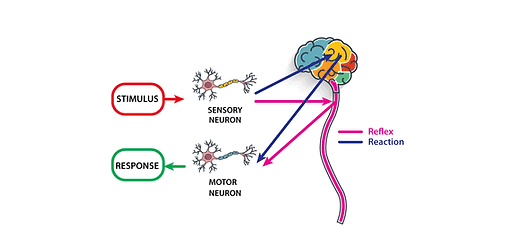- Posted in: Timing Systems
We get this question a lot. Electronic timing exists to improve accuracy and consistency when compared to hand timing. Research shows (ref 1, 2) that experienced coaches timing the 40 yard dash are off by an average of 0.22-0.31 sec when compared to hand timing.
Why is this?
Reaction time! When you see the athlete move, information travels from sensory cells called neurons from the eye to the brain’s visual cortex, an area devoted to understanding what you see. Next, the motor cortex—the part of the brain that directs movement—has to send signals along your spinal cord and to your arm, hand and finger muscles, telling them to respond in the proper sequence to press a button on the stopwatch. The average reaction time is 0.15-0.30 sec. (ref 3) but that takes into account physical, audio, and visual stimuli. The reaction time for a physical interaction is closer to 0.15 sec as the “knee jerk” reaction is directed by the spinal cord as opposed to the brain – shortening up the distance and computation needed to react. Audio reactions are about 0.17 sec, and visual – which is the case in timing – is typically at least 0.25 sec (ref 4).

But if I start the clock 0.3 sec after the athlete starts, and then stop it 0.3 sec after the athlete crosses the finish – won’t that cancel out?
Sure – but it doesn’t work that way. The start is where you are reacting to movement. At the finish you are anticipating the athlete crossing the line so your brain is calculating when to press the button based off how fast the athlete is moving. As a result, there is a lot less error at the finish – so they do not cancel out.
There you have it! That is why you see a difference in hand timing vs. laser timing.
Another thing that can greatly impact the accuracy and consistency of hand timing are distraction. There are a lot of distractions when testing athletes. “Coach what was my time?”, directing athletes to get up to the line, coaching them up on how to start, etc. These distractions were limited in the referenced articles, so even though a ~0.3 sec average difference was recorded, it has the potential to be much further off.
References
- Comparison Between Hand and Electronic Timing of 40-yd Dash Performance in College Football Players
- Validity and reliability of hand and electronic timing for 40-yd sprint in college football players
- Speedy Science: How Fast Can You React?
- Human Reaction Time | Forces & Motion | Physics | FuseSchool
The Dashr timing system has been validated for accuracy and consistency. See this article for reference.
